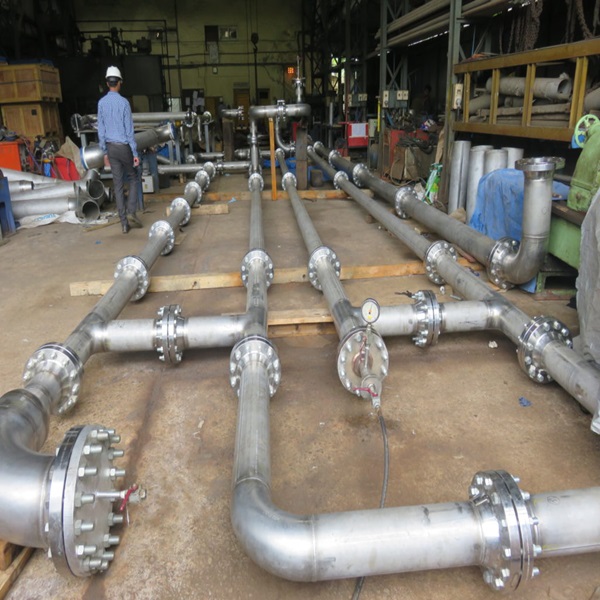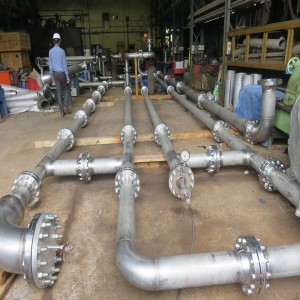Pipe spool
What Does Pipe Spool Mean?
Pipe spools are pre-fabricated components of a piping system. The term “pipe spools” is used to describe pipes, flanges, and fittings that are produced before they are incorporated into a piping system. Pipe spools are pre-shaped to facilitate assembly using hoists, gauges, and other tools for joining the parts. Pipe spools unite long pipes with flanges from the end of the long pipes so that they can be bolted with each other with matching flanges. These connections are embedded inside concrete walls before the pouring of concrete. This system must be aligned properly before concrete pouring, as it must be able to withstand the weight and force of the structure.
Pre-Fabrication of Pipe Spools
Roll correction and welding process are fitting of the main pipe by rolling machine and the welder does not need to change his situation, and also the position of fitting and welding occur when more than one branch of the long pipe overcome the clearance limit. To create a more efficient piping system and save time, pipe spool pre-fabrication is used. Because if the system did not produce preliminary, the welding of the system will take much more time and the welder has to move over the main pipe to accomplish fitting or welding.
Why Pipe Spools are Pre-fabricated?
Pipe spools are pre-fabricated to reduce field installation costs and provide higher quality in the products. They are generally flanged to obtain the connection to other spools. The spool fabrication is normally performed by special companies having the required infrastructure. These specialist fabricators produce the system under the specified set of quality and accuracy to obtain proper fit at the site and to maintain the necessary technical properties defined by the client.
Mainly used pipeline systems are generally:
Steel pipes
For the supply of water and flammable gases, steel pipes are the most useful pipes. They are used in many homes and businesses to transfer natural gas or propane fuel. They also used for fire sprinkler systems due to their high heat resistance. The durability of steel is one of the best advantages of the pipeline systems. It is strong and it can withstand the pressures, temperatures, heavy shocks, and vibrations. It also has unique flexibility which provides an easy extension.
Copper pipes
Copper pipes are mostly used for the transportation of hot and cold water. There are mainly two types of copper pipes, soft and rigid copper. Copper pipes joined using flare connection, compression connection, or solder. It is expensive but offers a high level of corrosion resistance.
Aluminum pipes
It is used due to its low cost, resistance to corrosion and its ductility. They are more desirable than steel for the conveyance of flammable solvents because of none spark formation. Aluminum pipes can be connected by the flare of compression fittings.
Glass pipes
Tempered glass pipes are used for specialized applications, such as corrosive liquids, medical or laboratory wastes, or pharmaceutical manufacturing. Connections are generally made using a specialized gasket or O-ring fittings.
Pre-Fabrication Advantages (Reducing Cost In Pre-Fabrication, Inspection, And Testing)
In controlled environments, the quality of the work is easier to manage and maintain.
Specified tolerances avoid rework at the site because of high accuracy.
Fabrication is weather independent, so it minimizes the production delays.
The pre-fabrication process is the best advantage because it provides less workforce for the fabrication of spools on site.
Mass production manufacturing results in lower manufacturing costs in comparison with site fabrication.
Lesser fabrication and assembly time needed for pre-fabricated spools, with this way, extra time and cost wastage is avoided.
Pre-fabricated spools want little investments in production and testing equipment by the users. For better and efficient performances, Radiography, PMI, MPI, Ultrasonic tests, Hydro tests, etc. can be used.
To obtain a lesser probability of rework at the site, better control of welding parameters must be done in the controlled environments.
Power availability is not necessary.
Unnecessary time delays are avoided.
The Main Disadvantage Of Making Pipe Spools
Making pipe spools has wonderful benefits but the main disadvantage is the not fitting on site. This problem causes terrible results. One small mistake in the pre-production of pipe spools causes a non-fitting system in the working environment and creates a huge problem. When this problem occurs, pressure tests and x-rays of the welds must be checked again and re-welding should be needed.
As a professional pipe supplier, Hnssd.com can provide steel pipes, pipe fittings, and flanges in a variety of dimensions, standards, and materials. Should you require further information regarding our products, we kindly request that you contact us: sales@hnssd.com
Pipe spool size
| Production method | Material | Size range & pipe spool dimensions | Schedule / Wall Thickness | |
|---|---|---|---|---|
| Minimum thickness (mm) Schedule 10S |
Maximum thickness (mm) Schedule XXS |
|||
| Seamless Fabricated | Carbon steel | 0.5 – 30 Inch | 3 mm | 85 mm |
| Seamless Fabricated | Alloy steel | 0.5 – 30 Inch | 3 mm | 85 mm |
| Seamless Fabricated | Stainless steel | 0.5 – 24 Inch | 3 mm | 70 mm |
| Welded Fabricated | Carbon steel | 0.5 – 96 Inch | 8 mm | 85 mm |
| Welded Fabricated | Alloy steel | 0.5 – 48 Inch | 8 mm | 85 mm |
| Welded Fabricated | Stainless steel | 0.5 – 74 Inch | 6 mm | 70 mm |
Specification of pipe spool
| Pipe spool dimensions | Flanged pipe spool standard | Certification |
|---|---|---|
|
|
|
| Common welding methods followed by pipe spool manufacturers | Welding standard | Welder test |
|
|
|
| Hardness | Spool fabrication services | Pipe spool identification |
|
Contact above listed pipe spool manufacturers for your specific requirements |
|
| Pipe spool hs code | Documentation | Testing |
|
|
|
| Code & standard | End-Prep | Marking Details |
|
|
Material wise cutting and marking process
|
| Heat-treatments | Storage & Packaging Protection tips | Industries |
|
|
|
Pipe spool length
| Minimum pipe spool length | 70mm -100mm as per requirement |
| Maximum pipe spool length | 2.5m x 2.5m x 12m |
| Standard pipe spool length | 12m |
Compatible pipe fittings and flanges for pipe spool fabrication
| Material | Pipe | Compatible pipe fittings | Compatible flanges |
|---|---|---|---|
| Carbon steel pipe spool |
|
|
|
| Stainless steel pipe spool |
|
|
|
| Titanium pipe spool |
|
|
|
|
|
|
|
| Duplex / Super duplex/ SMO 254 pipe spool |
|
|
|
| Copper nickel/ Cupro Nickel pipe spool |
|
|
|
Pipe spool fabrication process
| Method 1 | Roll welding/ Roll fitting and welding | |
| Method 2 | Position welding/ Permanent position fitting and welding |
Material wise suitable welding methods
| Can be weld | Not able to weld | |
|---|---|---|
| FCAW | Carbon steels, cast iron, nickel based alloys | Auminum |
| Stick welding | Carbon steels, nickel based alloys, Chrome, ss, even Aluminum but not the best Best to weld thicker metals |
Thin sheet metals |
| Tig welding | Best for steel & aluminium for precise & small welds |
Pipe spool welding certification processes
- TIG welding – GTAW (Gas Tungsten Arc Welding)
- Stick welding – SMAW (Shielded Metal Arc Welding)
- MIG welding – GMAW (Gas Metal Arc Welding)
- FCAW – Wire Wheel welding/ Flux Core Arc Welding
Pipe spool welding certification positions
| Pipe Welding | Certification Position |
|---|---|
| 1G Welding | horizontal position |
| 2G Welding | vertical position |
| 5G Welding | horizontal position |
| 6G Welding | standing on a 45 degree angle |
| R | restricted position |
Joints types of fabricated spools
- F is for a fillet weld.
- G is for a groove weld.
Pipe spool fabrication tolerances
| Wrought bends | Max 8% pipe OD |
| Flange face to flange face or pipe to flange face | ±1.5mm |
| Flange faces | 0.15mm / cm (width of joint face) |
Minimum pipe spool piece between welds
Code & standard for Pup/ short piece of pipe or pipe spool piece between welds
- Choose the length of pipe spool minimum of 2 inch or 4 times of wall thickness to keep butt weld little far to avoid overlapping weld
- As per Australian Standard AS 4458 – distance between the edge of 2 butt welds should be minimum 30 mm or 4 times pipe wall thickness




